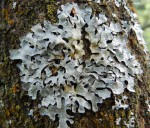Lichens are an abundant and very diverse group, with the BLS estimating that there are over 2000 species in the UK, with many new species and morphs being found, and added to the list each year! Across the globe there are believed to be around 17,000 species and across Whiteknights Campus, 55 species have been recorded, this could no doubt be significantly expanded with more recorder time. Lichens have a number of growth forms and the four likely to be seen on Campus are:
Crustose: These form a tight crust over their substrate, very often blending in to the background, so they often go un-noticed. A species found on campus matching such a description is Lecidella elaeochroma, see image 1.
Foliose: These form plate like structures just above their substrate, attaching themselves as they spread out, so are often clearly visible. These plates often overlap each other and other species. A species found on campus matching such a description is Parmelia sulcata, see image 2.
- Image 1 Crustose – Lecidella elaeochroma © Justin Groves The University of Reading
- Image 2 Foliose – Parmelia sulcata © Justin Groves The University of Reading
- Image 3 Fruticose – Ramalina farinacea © Justin Groves The University of Reading
- Image 4 Leprose – Lepraria genus © Justin Groves The University of Reading
- Image 5 Special case for Cladonia – Cladonia sp. © Justin Groves The University of Reading
Fruiticose: These form clearly visible branched structures just above the substrate, often erect and with all growth from the tips. A species found on campus matching such a description is Ramalina farinacea, see image 3.
Leprose: These look like grey green or yellow dust on the surface an object. A genus found on campus is Lepraria see image 4, speciating these species involves chemical testing.
Also the genus Cladonia see image 5 (showing two species), are unique in having two growth forms that occur on the same species together, producing both foliose (squamules) and fruiticose (podetia) growths.
The main area of a lichen that you can see, is the thallus and the fruiting bodies, which have a variety of forms and names. For example, lichens commonly found on campus have can have:
- Flat, disc-shaped bodies known as apothecia
- Flask-shaped fruiting bodies, which are often sunk within the lichen and visible only as a slight raised bump, with a pore in the top, called perithecia.
- The pycnidia may also be seen, embedded in the thallus as flask like structures, they can allow the lichen to reproduce asexually see more in lichens symbiosis part 3.
- There are also many other types of lichen fruiting body across the world and the UK
The adaptions of the above growth forms are a result of the fungal structures. The fungal structures can rapidly absorb water and moisture from the atmosphere into the growing structure when it is present. However, as they have no means to store water, they rapidly dehydrate in dry weather. Nevertheless, this does not kill them, as they have biochemical and physiological methods to prevent damage, when they dehydrate. As a result, lichens can be found on most surfaces from on trees in deep shade, to buildings and to the rocks within rivers.
I would like to thank Fay Newbery for her significant help towards creating this blog. As well as Dr Jonathan Mitchley for initial Identifications of lichens.
If you are interested in British Lichens then you might like to visit the British Lichen Society web site.
Or take a look at the following publications:
Nash III, H.T., 2010. Lichen Biology. 2nd ed. New York: Cambridge University Press
Gilbert, O., 2000. Lichens. London: HarperCollins
Purvis, P., 2000. Lichens. London: The Natural History Museum
Duncan, U. K. and James, P.W., 1970. Arbroath: T.buncle & CO. Ltd.





